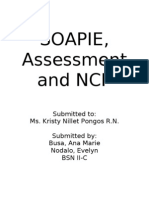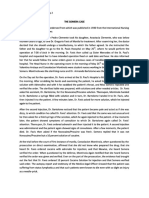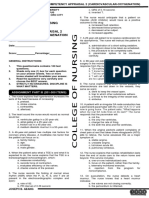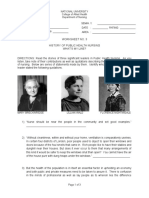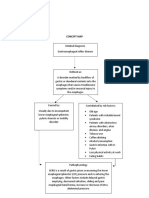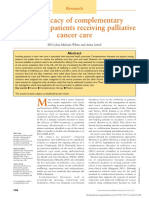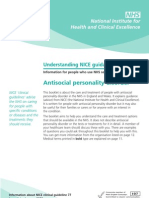0 ratings0% found this document useful (0 votes)
286 viewsTranscultural Perspective in The Nursing Care of Adults Physiologic Development During Adulthood
Transcultural Perspective in The Nursing Care of Adults Physiologic Development During Adulthood
Uploaded by
euLa-mayzellThis document discusses developmental transitions throughout adulthood from multiple perspectives. It addresses physiological, psychological, and social development. Key points include:
1) Adulthood development is influenced by culture, gender, socioeconomic status, and life experiences like marriage, career changes, and health issues.
2) Developmental tasks in middle adulthood include achieving generativity through parenting, career, and community involvement.
3) Cultural norms shape expectations around marriage, independence, family roles and responsibilities.
4) Health crises and caregiving responsibilities also represent developmental transitions that nurses must consider culturally.
Copyright:
Attribution Non-Commercial (BY-NC)
Available Formats
Download as DOC, PDF, TXT or read online from Scribd
Transcultural Perspective in The Nursing Care of Adults Physiologic Development During Adulthood
Transcultural Perspective in The Nursing Care of Adults Physiologic Development During Adulthood
Uploaded by
euLa-mayzell0 ratings0% found this document useful (0 votes)
286 views5 pagesThis document discusses developmental transitions throughout adulthood from multiple perspectives. It addresses physiological, psychological, and social development. Key points include:
1) Adulthood development is influenced by culture, gender, socioeconomic status, and life experiences like marriage, career changes, and health issues.
2) Developmental tasks in middle adulthood include achieving generativity through parenting, career, and community involvement.
3) Cultural norms shape expectations around marriage, independence, family roles and responsibilities.
4) Health crises and caregiving responsibilities also represent developmental transitions that nurses must consider culturally.
Original Title
Report 2
Copyright
© Attribution Non-Commercial (BY-NC)
Available Formats
DOC, PDF, TXT or read online from Scribd
Share this document
Did you find this document useful?
Is this content inappropriate?
This document discusses developmental transitions throughout adulthood from multiple perspectives. It addresses physiological, psychological, and social development. Key points include:
1) Adulthood development is influenced by culture, gender, socioeconomic status, and life experiences like marriage, career changes, and health issues.
2) Developmental tasks in middle adulthood include achieving generativity through parenting, career, and community involvement.
3) Cultural norms shape expectations around marriage, independence, family roles and responsibilities.
4) Health crises and caregiving responsibilities also represent developmental transitions that nurses must consider culturally.
Copyright:
Attribution Non-Commercial (BY-NC)
Available Formats
Download as DOC, PDF, TXT or read online from Scribd
Download as doc, pdf, or txt
0 ratings0% found this document useful (0 votes)
286 views5 pagesTranscultural Perspective in The Nursing Care of Adults Physiologic Development During Adulthood
Transcultural Perspective in The Nursing Care of Adults Physiologic Development During Adulthood
Uploaded by
euLa-mayzellThis document discusses developmental transitions throughout adulthood from multiple perspectives. It addresses physiological, psychological, and social development. Key points include:
1) Adulthood development is influenced by culture, gender, socioeconomic status, and life experiences like marriage, career changes, and health issues.
2) Developmental tasks in middle adulthood include achieving generativity through parenting, career, and community involvement.
3) Cultural norms shape expectations around marriage, independence, family roles and responsibilities.
4) Health crises and caregiving responsibilities also represent developmental transitions that nurses must consider culturally.
Copyright:
Attribution Non-Commercial (BY-NC)
Available Formats
Download as DOC, PDF, TXT or read online from Scribd
Download as doc, pdf, or txt
You are on page 1of 5
TRANSCULTURAL PERSPECTIVE IN THE NURSING CARE OF ADULTS
Physiologic Development during Adulthood
Women undergo menopause a gradual decrease in ovarian function with
subsequent depletion of progesterone and estrogen. While these physiologic changes
occur, self-image and self-concept change also.
Men also have physical and emotional changes from the decreased level of
hormones. Loss of muscle mass and strength and a possible loss of sexual potency occur
slowly.
Psychosocial Development during Childhood
Development in adulthood was termed the “empty middle” by Bronfenbrenner,
(1977). A noted developmental psychologist, he implied that this term was an indication
of Western culture’s lack of interest in the adult years.
Divorce, remarriage, career change, increased mobility, the sexual revolution, and
the women’s movement have had a profound impact on the adult years. The middle-aged
adult may be caught in the sandwich generation still concerned with older children (and
sometimes grandchildren) but increasingly concerned with the care of aging parents.
Middle life can be a time of reassessment, turmoil, and change. Society acknowledges
this with common terms such as midlife crisis or even empty nest syndrome, along with
other terms that imply stress, dissatisfaction, and unrest.
Chronologic Standards for Appropriate Adult Behavior
Much of the work on adult development was done in the 1960s and 1970s by
developmental psychologists such as Bronfenbrenner (1977), Neugartenm (1968), and
Havighurst (1974), all of whom proposed different theories about adult development.
Menarche is a milestone in women’s development and a psychologically
significant event, providing a rather dramatic demarcation between girlhood and
womanhood. However, this is not an event that is celebrated openly in U.S. culture as
most girls are too embarrassed to talk openly about it with anyone but their mother or
close friends. There are no definitive boundaries that mark adulthood for either young
girls or young boys, although legal sanctions confer some rights and responsibilities at
the ages 18 and 21 years. Examples are the age requirements for obtaining a driver’s
license, for voting, and for purchasing alcohol and tobacco.
Adulthood as such is usually divided into young adulthood (late teens, 20s, and
30s) and middle adulthood (40s and 50s), but age lines can be fuzzy.
“Re-careering” or changing careers during middle adulthood is also becoming
more common and can be a source of change.
Developmental Tasks
Throughout life, each individual is confronted with developmental tasks:
responses to life situations encountered by all persons experiencing physiologic,
psychologic, spiritual, and sociologic changes.
Several theorists have studied and defined the developmental or, midlife tasks of
adulthood. Many personality theorists, for example, Freud, Erikon, and Fromm, cite
maturity as the major criterion of adulthood. These various theories have implications for
how we define: development”,”maturity”, and “wisdom”. According to Erikson (1963),
the developmental task of middle adulthood is the attainment of generativity versus
stagnation. Generativity is accomplished through parenting, working in one’s career,
participating in community activities, or working cooperatively with peers, spouse,
family members, and others to reach mutually determined goals.
In many ways, the early theorists’ views of what occurs in adulthood are the
biases of “White” middle-class values and experiences. This constellation of
characteristics has been attributed to predominantly White, Anglo-Saxon, Protestant
(WASP) views and behaviors.
Early studies on the developmental experiences of women have led several
authors (Belenky, McVicker, Clinchy, Goldberger & Tarule, 1997) to suggest that
developmental stages and the associated developmental tasks of adulthood have been
derived primarily from studies of men; thus women may experience adult development
somewhat differently. Women’s traditional location of responsibility was in the home,
nurturing children and husbands well as parents. This view is changing, prompted by
societal changes and informed by scholars who are addressing women’s psychosocial
development in new way.
Adulthood has been conceptualized as step-by-step phases of development, but
more recent theories (McCrae & Costa, 2003; Demick & Andreoletti, 2003) suggest that
development is an evolutionary expanse involving different eras and transitions. These
life transitions have triumphs, costs, and disruptions. Within nursing, Meleis, Sawyer, Im,
Hilfinger Messias, and Schumacher (2000) proposed a framework to study life
transitions. They suggest that transitions can be developmental, situational, health-illness,
and/or organizational.
Developmental Transition: Achieving Success in One’s Career
Some Americans define a “successful career” as financial success, while others
may see it as way to provide service or make a contribution to the lives of their fellow
citizens. The United States, as other countries in the world, has experienced a tremendous
influx of immigrants and refugees from Southeast Asia, Latin America, Eastern Europe,
Africa and other areas.
Developmental Transition: Achieving Social Civic Responsibility
Social and civic responsibilities are in part culturally defined. Whereas members
of the dominant North American culture may value achieving an elected office in the
local Parent Teacher Association (PTA) or Rotary Club, other cultures may find these
goals baffling and emphasize other activities within the cultural group.
Middle Eastern and Southeast Asian cultures emphasize responsibilities and
contributions to the extended family or clan rather than to the wider society. Lipson and
Miller (1994) reported that Afghan women in the United States continue to socialize
almost exclusively with other Afghan women, usually extended family members.
Developmental Transition: Marriage and Raising Children to Adulthood
The age at which young person marry and become independent varies by custom
or cultural norm as well as by socioeconomic status. Generally speaking, adults of lower
socioeconomic status leave school, begin work, marry, and become parents and
grandparents at earlier ages than middle-class or upper-class adults. It is relatively
common in North American society for an 18 year old, for example to marry and move
away from home.
Many American families encourage early independence or “leaving home”,
although this trend decreases when the economy declines. Middle East and Latin
America, place more emphasis on maintaining extended family. Families from some
cultural groups, such as Hispanics, or traditional religious groups, such as the Hutterites
or the Amish, may be reluctant to allow their young daughters to leave home until they
marry. In many Muslim families, girls do not leave home until they are married.
Developmental Transition: Changing Roles and Relationships
The relationship of wife and husband is often enhanced in middle adulthood,
although divorce at this time is not infrequent in the United States. In some Hispanic
cultures, women develop more intense relationships or affective bonds with their children
or relatives than with their husbands. Latin men in turn, may form close bonds with
siblings or friends-ties that meet the needs for companionship, emotional support, and
caring that might otherwise be expected from their wives. Touch between men (walking
arm in arm) and between women is acceptable in many societies. Gender roles and how
men and women go about establishing personal ties with their sex are heavily influenced
by culture. In North American society, women are more likely to have intimate, self
disclosing friendships with other women than men have with other men. In southern
Europe and the Middle East, men are allowed to express their friendship with each other
with words embraces. Such expressions of affection between men are uncommon in
North American culture and might be attributed to homosexuality.
Health-Related Situational Crises
Leading causes of death of middle adulthood are heart disease, cancer,
cerebrovascular disease, and accidents (Centers for Disease Control and Prevention
[CDC], National Center for Health Statistics, 2004). These conditions affect individuals,
but they also occur within a family system and affect children, spouses, aging parents, or
other close relative.
Medical treatment and nursing care must take into account the cultural history,
values, beliefs, and practices that influence the client’s and family’s ability to cope with
the illness, as well as assessing whether the interventions are congruent with their culture.
Caregiving and African American Women
African American women, like all women, receive and provide health care in the
context of the families in which they perform multiple caregiving roles: as wives,
mothers, daughters, widows, single childless women, and so on. Women’s assumption of
the caregiving role is in line with traditional expectations of women’s domestic role, and
the majority of caregivers are women; therefore, it is not surprising that the caregiving
roles of women often predispose them to interrupted employment and limited access to
health care insurance and pension and retirement plans. Shambley-Ebron & Boyle
(2006a, 2006b) have documented that these general problems and characteristics of
caregivers are compounded for African American women by the special circumstances of
their lives and the lives of the men and children for whom they care. In the case of
African American caregivers, prejudice, discrimination and poverty all interact to
increase stress and pose challenges that frequently result in poor health.
Caregiving implies the provision of long-term help to an impaired family meme
or close friend. Caregiving usually is labor intensive, time consuming, and stressful,
although the exact effects on the physical and emotional health of caregivers are still
documented. Although positive outcomes, such as feelings of reward and satisfaction, do
not occur for caregivers, they still experience negative psychological, emotional, social,
and physical outcomes. When caregiving for other family members takes place during
middle adulthood, the roles and challenges for both the caregiver and the recipient may
change. Wright observed that “caregiver research is based predominantly on White
subjects, and ethnic differences are rarely analyzed”.
Studies of African American caregivers have found that they tend to use religious
belief to help them cope with the stress of caregiving. Boyle, Hodnicki, and Ferrell
(1999) described Black caregivers’ belief in a personal God and their intense relationship
with Him provided them with support during the illness of a family member and helped
them cope with death and loss. Poindexter, Linsk, and Warner (1999) also found that a
major source of support for Black caregivers was their personal relationships with
“Jesus”,”God”, or “the Lord”. Poindexter, Linsk, and Warner suggest that spirituality is
both personal and empowering for some African Americans and is related to the deepest
motivations in life.
African American women also face a special situation in relationship to
HIV/AIDS. African American women are especially hard hit by HIV/AIDS. From 2001-
2004, African American women accounted for 68% of HIV/AIDS diagnoses for women
in the 33 states that have confidential, named-based HIV reporting, and three-fourths of
the HIV/AIDS cases in African American women were caused by heterosexual contact.
Shambley-Ebron and Boyle (2006b) studied the African American women were
diagnosed with HIV/AIDS and who were caring for children who were also HIV positive.
These mother caregivers relied on spiritual traditions and religious practices to help deal
with the pressures of living and mothering with HIV/AIDS.
The context of HIV/AIDS and the African American Community
HIV/AIDS disproportionately affects African Americans and has had a
devastating effect on African American communities. The CDC points out that at every
stage-from HIV diagnosis through the death of person with AIDS-the hardest hit racial or
ethnic group is African Americans. Even though African Americans make up only
approximately 13% of the U.S. population, one-half of the estimated new cases of
HIV/AIDS diagnoses in the U.S. in 2004 WERE FOR African Americans.
Prevention Challenges
From a public health standpoint, preventive education about HIV/AIDS has been
hindered by an unwillingness to talk frankly about sexual and drug use behaviors, and
this has been a substantial barrier in the effective HIV preventive programs. In essence,
the AIDS epidemic has forced society to examine and attempt to alter cultural behaviors
and values that were largely ignored in the past.
Over the past 2 decades in the United States, the practice of high0risk HIV
behaviors has changed from selected populations of White homosexual men with no
history of drug use to heterosexuals having multiple sex partners and using drugs. More
than three-fourths of the HIV/AIDS cases diagnosed for African-American women from
2001-2004 were caused by heterosexual contact. Injection drug use accounted almost
one-fifth of all cases. In 2004, the rate of AIDS diagnoses for African American women
was 23 times the rate for White women and 4 times more than that for Hispanic women
(CDC, U.S. Department of Health and Human Services, 2007a).
Barriers to HIV Preventive Efforts in African American Communities
Poverty: African Americans, generally speaking, often have lower incomes than other
Americans.
Denial: Many African Americans still believes that HIV/AIDS is mostly a White, gay
male disease and that it is a problem in Newark or New York, or even in Florida, but not
in rural Georgia or Alabama.
Drug Use: Injecting drugs is the second leading cause of HIV infection for African
American women and the third leading cause of HIV infection for African American
Men.
Culturally-Competent Nursing Care of an African American Woman Experiencing
a Situational Crisis
A phenomenon that is becoming more common is that of HIV-affected caregivers,
either mothers or grandmothers, who are caring for family members who are also HIV
positive. Some caregivers are caring for one or more family members who need care and
attention in addition to the person(s) diagnosed with HIV, and such caregivers are often
caught between multiple sets of caring responsibilities. In the past decade or so, the
nature of caregiving has changed with the impact of the AIDS epidemic because AIDS
affects a much younger population. At first, caregivers to persons with AIDS often were
men. Like many other Americans, most African Americans thought Aids was a disease of
White homosexual men, so it was something of a shock when rural African American
families learned that one of their own family members have HIV disease. HIV/AIDS still
carries a tremendous stigma in African American communities. Many African
Americans, especially younger adults or teenagers, now commonly refer to HIV/AIDS as
“the virus”. Culturally appropriate ways in which the nurse might implement nursing care
are suggested. The use of traditional family and religious systems is encouraged because
these ties are of particular significance in rural African American culture.
You might also like
- Breaking Free WorkbookDocument444 pagesBreaking Free WorkbookRobert Fry100% (11)
- TAHBSO Concept MapDocument1 pageTAHBSO Concept MapSherika Mariz Moreno GuarinNo ratings yet
- Child Care BookDocument144 pagesChild Care BookGrace YesayaNo ratings yet
- Sa332a-1702en PDocument6 pagesSa332a-1702en PBobby Chipping0% (2)
- 1.MOD On GERON (1) CommunicationDocument19 pages1.MOD On GERON (1) CommunicationPatricia VasquezNo ratings yet
- Reflective Essay-Rexson A. DalanginDocument3 pagesReflective Essay-Rexson A. DalanginRexson Alcantara DalanginNo ratings yet
- Soapie, Assessment and NCP On PAINDocument7 pagesSoapie, Assessment and NCP On PAINAna100% (2)
- Gastric AdenocarcinomaDocument4 pagesGastric AdenocarcinomaJimel Vital Carreon100% (2)
- SP CSDocument4 pagesSP CSKhan HansNo ratings yet
- Rabe 4 CHN NutriDocument7 pagesRabe 4 CHN NutriBasa, Rica Mae P.No ratings yet
- CMCQDocument31 pagesCMCQJim Christian EllaserNo ratings yet
- Spiritual and Moral ResponsibilitiesDocument206 pagesSpiritual and Moral ResponsibilitiesJoy JarinNo ratings yet
- NCP SmokingDocument1 pageNCP SmokingRuby GuarinNo ratings yet
- Republic ActDocument36 pagesRepublic ActjanNo ratings yet
- NCM 117 Final Exam MamelDocument16 pagesNCM 117 Final Exam MamelJade CentinoNo ratings yet
- En Notes EscDocument7 pagesEn Notes EscCG Patron BamboNo ratings yet
- Assignment For Oxy. Online BasedDocument5 pagesAssignment For Oxy. Online BasedNurhassem Nor AkangNo ratings yet
- PUCAN, Julienne BSN III-D - SGD - HYPO&HYPERCHLOREMIADocument10 pagesPUCAN, Julienne BSN III-D - SGD - HYPO&HYPERCHLOREMIAJulienne PucanNo ratings yet
- Cellular AberrationDocument14 pagesCellular AberrationjinahyangNo ratings yet
- 2.1 NCM 210 RLE - Types of Family-Nurse ContactDocument6 pages2.1 NCM 210 RLE - Types of Family-Nurse ContactLYRIZZA LEA BHEA DESIATANo ratings yet
- Myocardial Infarction (Diseases For Oral Revalida)Document12 pagesMyocardial Infarction (Diseases For Oral Revalida)Suzette PipoNo ratings yet
- Group 4 NCM 114Document14 pagesGroup 4 NCM 114ESTELLE VERA O. VELEZNo ratings yet
- Evaluation Examination For Medicine WardDocument3 pagesEvaluation Examination For Medicine WardMarvick GalimaNo ratings yet
- NCPDocument4 pagesNCPAndrea BroccoliNo ratings yet
- Topic 1: Introduction To Geria Nursing: Activity 1.1: Grandparents' LoveDocument11 pagesTopic 1: Introduction To Geria Nursing: Activity 1.1: Grandparents' LoveMarissa AsimNo ratings yet
- Final Exam NCM 117 A - Section BDocument43 pagesFinal Exam NCM 117 A - Section BEzra Miguel DarundayNo ratings yet
- Simple Schematic Diagram of PneumoniaDocument1 pageSimple Schematic Diagram of PneumoniaJason A. AdoyoganNo ratings yet
- The Somera Case CompressDocument3 pagesThe Somera Case CompressAizel ManiagoNo ratings yet
- Nursing Care Plan - Alteration in Bowel Elimination - ConstipationDocument1 pageNursing Care Plan - Alteration in Bowel Elimination - ConstipationArlan AbraganNo ratings yet
- Disaster Preparedness - Leadership and Coordination in Disaster in Health Care System With LectureDocument29 pagesDisaster Preparedness - Leadership and Coordination in Disaster in Health Care System With LectureArvie ReyesNo ratings yet
- Chest Tube Reflective EssayDocument2 pagesChest Tube Reflective EssayAnjae GariandoNo ratings yet
- Daily Plan of ActivityDocument4 pagesDaily Plan of ActivityEnohoj YamNo ratings yet
- TCN 1Document22 pagesTCN 1Glory Anne Joy WillyNo ratings yet
- Ca 2 Cardiovascular-Oxygenation Assignment Part 1Document8 pagesCa 2 Cardiovascular-Oxygenation Assignment Part 1Joseph AbangNo ratings yet
- Intensive Nursing Practicum: Bachelor of Science in NursingDocument9 pagesIntensive Nursing Practicum: Bachelor of Science in NursingMichelle Gliselle Guinto MallareNo ratings yet
- Worksheet 3-What's My LineDocument3 pagesWorksheet 3-What's My LineKate MassonNo ratings yet
- Care of Clients With Life Threatening Conditions, Acutely Ill/Multi-Organ Problems, High Acuity, and Emergency SituationDocument75 pagesCare of Clients With Life Threatening Conditions, Acutely Ill/Multi-Organ Problems, High Acuity, and Emergency SituationleonielainecolbornNo ratings yet
- LFD PediaDocument1 pageLFD PediaLadybelle GototosNo ratings yet
- Nursing DiagnosisDocument10 pagesNursing DiagnosisZaty ChaiyOkk100% (1)
- AURELIO-Issues, Trends and Challenges On The Care of Older Persons in The Different SettingsDocument15 pagesAURELIO-Issues, Trends and Challenges On The Care of Older Persons in The Different Settings3D - AURELIO, Lyca Mae M.No ratings yet
- Focus-Nursing Care Plan For Sleep DisordersDocument9 pagesFocus-Nursing Care Plan For Sleep DisordersMae AzoresNo ratings yet
- Activity 11 Cardiac Tamponade NCPDocument3 pagesActivity 11 Cardiac Tamponade NCPCloe CorpuzNo ratings yet
- Concept MapDocument3 pagesConcept MapSophia PandesNo ratings yet
- Pci ActivitiesDocument5 pagesPci ActivitiesAl DavidNo ratings yet
- NCP Micu Hascvd Cad - RioDocument5 pagesNCP Micu Hascvd Cad - RioRio BonifacioNo ratings yet
- Laws Affecting The Practice of Nursing in The PhilippinesDocument6 pagesLaws Affecting The Practice of Nursing in The PhilippinesHuey Manalang Javier100% (1)
- Group 3 Unit 8 Transcultural Perspectives in The Nursing Care of Older AdultsDocument5 pagesGroup 3 Unit 8 Transcultural Perspectives in The Nursing Care of Older AdultsMYKRISTIE JHO MENDEZNo ratings yet
- Sodoso - Unit Task - M6Document3 pagesSodoso - Unit Task - M6Wench Ryechelle SodosoNo ratings yet
- Impaired Tissue Perfusion Related To The Weakening / Decreased Blood Flow To The Area of Gangrene Due To Obstruction of Blood VesselsDocument3 pagesImpaired Tissue Perfusion Related To The Weakening / Decreased Blood Flow To The Area of Gangrene Due To Obstruction of Blood VesselsKat AlaNo ratings yet
- Sample Family NCP - Community Health NursingDocument2 pagesSample Family NCP - Community Health Nursingalor100% (1)
- Nursing Care Plan Acute PainDocument2 pagesNursing Care Plan Acute PainAdelaine LorestoNo ratings yet
- Uterine Rupture: Mariano Marcos StateDocument10 pagesUterine Rupture: Mariano Marcos StateSalvaje CaballeroNo ratings yet
- Nursing LawsDocument4 pagesNursing LawsinosentenghanginNo ratings yet
- Bronchitis PathophysiologyDocument1 pageBronchitis PathophysiologyFerry Reyes0% (1)
- System Normal Abnormal Remarks Vital SignsDocument3 pagesSystem Normal Abnormal Remarks Vital SignsJM RomiasNo ratings yet
- PD 48 - Four (4) Children With Paid Maternity Leave PrivilegeDocument12 pagesPD 48 - Four (4) Children With Paid Maternity Leave PrivilegecnvfiguracionNo ratings yet
- The Nursing Diagnosis Body Image Disturbance Is Most Likely To Be Written For Which of The Following PersonsDocument3 pagesThe Nursing Diagnosis Body Image Disturbance Is Most Likely To Be Written For Which of The Following PersonsenzoNo ratings yet
- R.A. 9173Document8 pagesR.A. 9173Kaloy KamaoNo ratings yet
- TAHBSO ReportDocument4 pagesTAHBSO ReportsachiiMeNo ratings yet
- Ventricular Septal Defect, A Simple Guide To The Condition, Treatment And Related ConditionsFrom EverandVentricular Septal Defect, A Simple Guide To The Condition, Treatment And Related ConditionsNo ratings yet
- The Ride of Your Life: What I Learned about God, Love, and Adventure by Teaching My Son to Ride a BikeFrom EverandThe Ride of Your Life: What I Learned about God, Love, and Adventure by Teaching My Son to Ride a BikeRating: 4.5 out of 5 stars4.5/5 (2)
- COMPREHENSIVE NURSING ACHIEVEMENT TEST (RN): Passbooks Study GuideFrom EverandCOMPREHENSIVE NURSING ACHIEVEMENT TEST (RN): Passbooks Study GuideNo ratings yet
- Community Acquired Pneumonia, A Simple Guide To The Condition, Diagnosis, Treatment And Related ConditionsFrom EverandCommunity Acquired Pneumonia, A Simple Guide To The Condition, Diagnosis, Treatment And Related ConditionsNo ratings yet
- NCP and Learning Objectives For MeaslesDocument7 pagesNCP and Learning Objectives For MeaslesKhemz Dalde Lim67% (6)
- Article IjpnDocument6 pagesArticle Ijpndr harrieNo ratings yet
- FA#2 Essay - NERI (Elderly Health)Document2 pagesFA#2 Essay - NERI (Elderly Health)Angela NeriNo ratings yet
- A Cross Sectional Study of Caregiver Burden and Psychiatric Morbidity in Primary Caregivers of Mentally Retarded SubjectsDocument7 pagesA Cross Sectional Study of Caregiver Burden and Psychiatric Morbidity in Primary Caregivers of Mentally Retarded SubjectsKrishna RaoNo ratings yet
- CACHE Level 3 Award in Childcare and Education: Unit 2: Children's Health and Well-BeingDocument17 pagesCACHE Level 3 Award in Childcare and Education: Unit 2: Children's Health and Well-Beingjoel TorresNo ratings yet
- Franchising USA 2022-09 Senior Care SpecialDocument19 pagesFranchising USA 2022-09 Senior Care SpecialKelsie JacksonNo ratings yet
- Health Promotion PolicyDocument12 pagesHealth Promotion PolicyLalita A/P AnbarasenNo ratings yet
- Domains of Infant and Toddler /physical Development of A CHildDocument24 pagesDomains of Infant and Toddler /physical Development of A CHildTasneem SaifeeNo ratings yet
- Always Was Always Will Be Koori Children Inquiry Report Oct16.01Document140 pagesAlways Was Always Will Be Koori Children Inquiry Report Oct16.01Allan ClarkeNo ratings yet
- Occupational Therapy's Role in Adult Cognitive DisordersDocument2 pagesOccupational Therapy's Role in Adult Cognitive DisordersThe American Occupational Therapy AssociationNo ratings yet
- Stroke ManagementDocument108 pagesStroke ManagementYenny mardiatyNo ratings yet
- Factors Influencing NurseDocument14 pagesFactors Influencing NurseTimothy MakoriNo ratings yet
- I The Wifes Carer Men From The Traditionalists Silent Generation On Their IdentityDocument10 pagesI The Wifes Carer Men From The Traditionalists Silent Generation On Their IdentityNordsci ConferenceNo ratings yet
- Fine Gael General Election 2024 ManifestoDocument124 pagesFine Gael General Election 2024 ManifestoThe Journal of MusicNo ratings yet
- Case StudyDocument19 pagesCase StudyjohndaleparinasNo ratings yet
- 0117-21 Annan Academy HandbookDocument34 pages0117-21 Annan Academy HandbookLiz AlderNo ratings yet
- Discharge Planning ContohDocument114 pagesDischarge Planning ContohRatna EkawatiNo ratings yet
- Boundaries in Pastoral CareDocument30 pagesBoundaries in Pastoral CareNicky LockNo ratings yet
- Professional Role Development PlanDocument10 pagesProfessional Role Development Planapi-5327002330% (1)
- The PoemDocument5 pagesThe Poemsamaud0407No ratings yet
- COC 1.SAG - Caregiving (Grade Schooler) NC IIDocument2 pagesCOC 1.SAG - Caregiving (Grade Schooler) NC IIMarwin NavarreteNo ratings yet
- Whall Theory CritiqueDocument10 pagesWhall Theory Critiqueapi-273066575No ratings yet
- Calm Business 2023 Workplace Mental Health Trends ReportDocument53 pagesCalm Business 2023 Workplace Mental Health Trends ReportRikky MinyukuNo ratings yet
- Interpersonal & Interprofessional CollaborationDocument22 pagesInterpersonal & Interprofessional CollaborationShendi APNo ratings yet
- Practice Manager Job Description - Oct 2019Document3 pagesPractice Manager Job Description - Oct 2019M LubisNo ratings yet
- RPL FormDocument4 pagesRPL Formribeiro.plaisNo ratings yet
- Antisocial Personality Disorder: Understanding NICE GuidanceDocument12 pagesAntisocial Personality Disorder: Understanding NICE Guidanceaina_bilhahNo ratings yet






